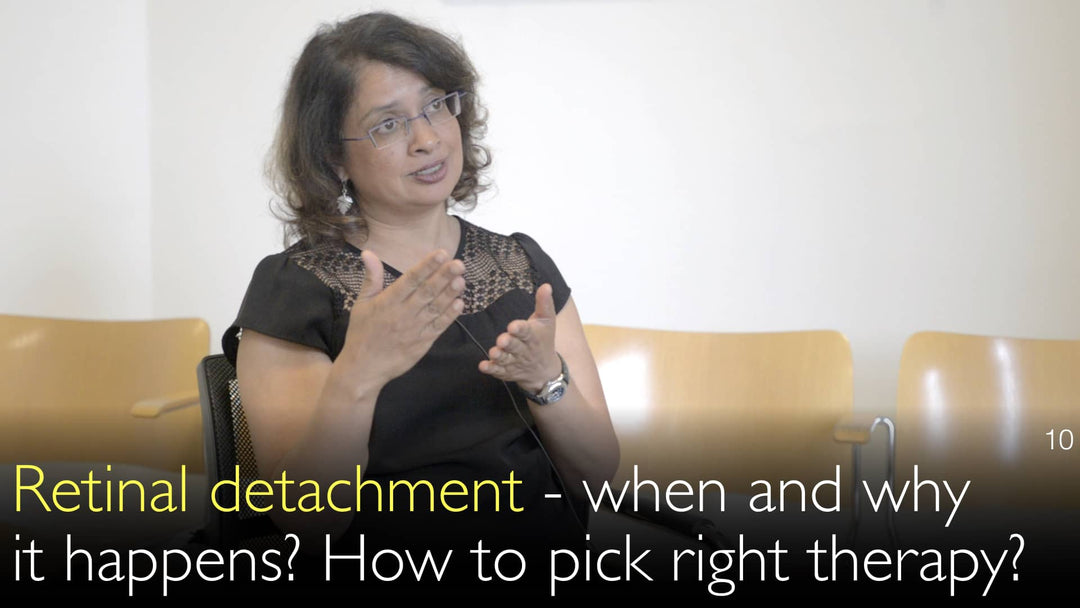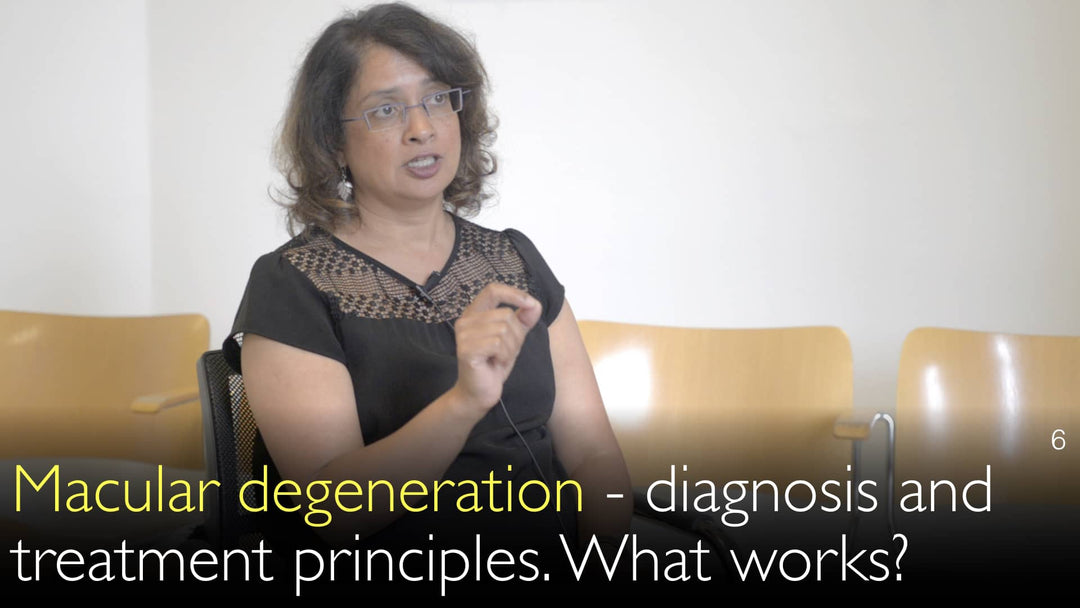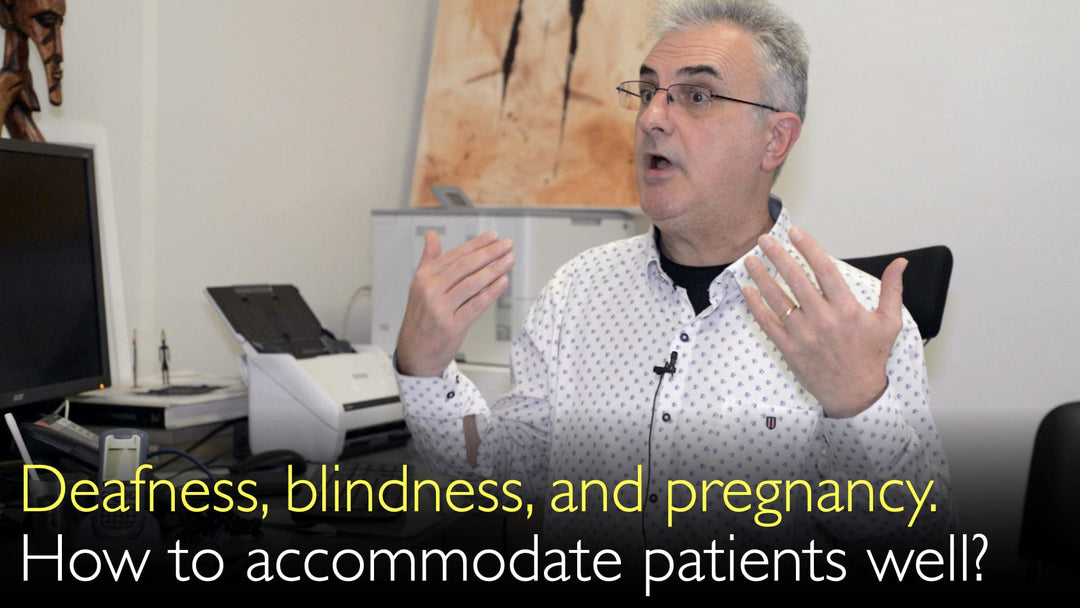Leading expert in retinal diseases, Dr. Francesca Cordeiro, MD, explains the causes, symptoms, and surgical treatment options for retinal detachment, a serious eye emergency where the retina pulls away from its supportive tissue. She details the critical impact of macular involvement on vision prognosis, the increased risk for patients with severe nearsightedness, and how modern vitrectomy procedures help prevent recurrence by meticulously sealing retinal tears.
Retinal Detachment Causes, Symptoms, and Surgical Repair Options
Jump To Section
- What is Retinal Detachment?
- Recognizing Retinal Detachment Symptoms
- Macular Involvement and Vision Prognosis
- Risk Factors for Retinal Detachment
- Surgical Treatment Options for Repair
- Preventing Recurrent Retinal Detachment
- Post-Surgery Recovery and Outcomes
What is Retinal Detachment?
Retinal detachment is a serious ophthalmologic emergency where the light-sensitive retina separates from the underlying layer of supportive tissue at the back of the eye. Dr. Francesca Cordeiro, MD, describes the mechanism: a hole or tear forms in the retina, allowing fluid from the eye's vitreous chamber to leak behind it. This fluid accumulation causes the sensory retina to pull away, disrupting its blood supply and function. Without prompt treatment, retinal detachment can lead to permanent vision loss.
Recognizing Retinal Detachment Symptoms
The onset of retinal detachment symptoms is often sudden and unmistakable. Patients typically experience a visual phenomenon described as a curtain falling over their field of vision. This profound and rapid vision loss is a hallmark sign that necessitates immediate medical attention. Other common symptoms can include a sudden increase in floaters (dark spots or squiggles), flashes of light (photopsia), and blurred vision. Dr. Anton Titov, MD, emphasizes that this recognizable problem invariably compels patients to seek urgent help.
Macular Involvement and Vision Prognosis
The prognosis for vision recovery after retinal detachment surgery is heavily dependent on whether the macula is involved. Dr. Francesca Cordeiro, MD, explains that the macula is the central part of the retina responsible for sharp, detailed central vision, akin to the focal point in a pinhole camera. When a detachment involves the macula, this complex structure is separated from its support, often resulting in permanent damage. Evidence suggests that any separation at the macula means a patient may never fully regain their best possible vision. Therefore, the speed of diagnosis and treatment before macular detachment occurs is a critical factor for a positive outcome.
Risk Factors for Retinal Detachment
Several key factors increase an individual's susceptibility to retinal detachment. The most significant risk factor is high myopia, or severe nearsightedness. Dr. Francesca Cordeiro, MD, notes that in myopic patients, the elongated eye geometry causes the retina to stretch and become thinner, making it more vulnerable to tears. Other risk factors include a previous eye surgery (like cataract surgery), a family history of retinal detachment, eye trauma, and certain other eye diseases. The condition is also cited as a potential risk factor in normal vaginal childbirth, sometimes influencing the decision to perform a Cesarean section.
Surgical Treatment Options for Repair
Retinal detachment requires prompt surgical intervention to reattach the retina and prevent irreversible vision loss. Dr. Francesca Cordeiro, MD, outlines the primary surgical techniques. One method involves placing a scleral buckle, a silicone band, around the outside of the eye to gently indent the wall and support the retina. A more common modern approach is vitrectomy, a procedure where the vitreous gel is removed from inside the eye. This allows the surgeon to directly access the retina, drain the subretinal fluid, and seal the retinal tear using laser (photocoagulation) or freezing therapy (cryopexy). The eye is then often filled with a gas or silicone oil bubble to hold the retina in place during healing.
Preventing Recurrent Retinal Detachment
While retinal detachment repair is typically successful, recurrence can happen, particularly in high-risk patients. Dr. Anton Titov, MD, discusses this concern with Dr. Francesca Cordeiro, MD. She confirms that patients who are very nearsighted have a higher risk of repeated detachments. The vitrectomy procedure itself is a key tool for prevention. By removing the vitreous gel, the surgeon gains a clear view to meticulously examine the entire peripheral retina for any additional small holes or weak areas that might have been missed and could cause a future problem. Sealing these potential entry points during the initial surgery is crucial for preventing recurrence.
Post-Surgery Recovery and Outcomes
Recovery from retinal detachment surgery involves a period of healing and specific post-operative positioning, often requiring the patient to keep their head in a certain direction to allow the gas bubble to effectively support the retina. Vision will be very blurry initially, especially if a gas bubble is used, and it may take several weeks to months for vision to stabilize. The final visual outcome is highly variable and depends on factors like the duration of the detachment and the extent of macular involvement. Dr. Francesca Cordeiro, MD, stresses that even with successful anatomical reattachment, some patients may not recover full functional vision, underscoring the critical importance of early detection and treatment.
Full Transcript
Retinal detachment is cited as a risk factor in normal vaginal childbirth. It is a potential indication for a Cesarean section. Leading eye diseases expert reviews retinal detachment diagnosis and treatment.
Dr. Anton Titov, MD: What is retinal detachment? Why does retinal detachment happen? What factors determine the prognosis in patients with retinal detachment? What is response to treatment?
Dr. Francesca Cordeiro, MD: Retinal detachment is when there is a hole or a tear in the retina. This means that fluid can leak behind the retina. Fluid comes from the front of the eye in the vitreous chamber. Fluid flows through the hole into the retina.
The part of the retina that senses light comes away from the rest of the retina. That problem is seen by the patient as a falling of the curtain. A curtain comes down over the patient’s vision. It is a very recognizable problem by a patient.
Because the patient suddenly loses their vision, they invariably want to do something about it. One of the things that is very difficult to predict is who is going to do well with the surgical operation to treat retinal detachment.
We do know that the retina detaches and it sometimes involves the macula. The macula is important. Sometimes you think of a pinhole camera. All the light rays going through the camera are focused to one central point. The same thing happens in the eye.
The macula is where you have your sharpest definition of the image. You may have a retinal detachment that involves the macula. The prognosis is less good because that whole very complex structure has come away from its support structure.
Therefore, you don't know if a patient necessarily will fully recover their vision. There is some evidence that suggests this. Any separation of retina at the macula area means that your patient will never go back to the best possible vision.
But this is how you treat macular degeneration. Usually, the tear of the retina is coming from a particular side of the retina, or it comes from the periphery of the retina. Usually, you hope that the patient presents very quickly to the eye specialist.
Dr. Anton Titov, MD: You hope to see a patient before their macula becomes detached. That increases the awareness and the prognosis for improvement in the vision. For patients with retinal detachment, sometimes they have a repeat retinal detachment.
Dr. Francesca Cordeiro, MD: Yes.
Dr. Anton Titov, MD: How often does retinal detachment recur after the treatment? Because sometimes it's a recurring problem. Retinal detachment shouldn't happen again after treatment, but sometimes repeat retinal detachment happens.
Dr. Francesca Cordeiro, MD: The patients who are at risk for repeat retinal detachment are those patients who are very near-sighted. If you are very short-sighted, your eye geometry changes. Stretching of the retina occurs.
The retina being thinner means that short-sighted patients are more susceptible to retinal detachment. They do possibly have more risk of repeated retinal detachments.
However, a lot of the time nowadays the retinal detachment treatment procedure involves intraocular surgery. There are some ways of doing this retinal detachment repair. You insert a buckle on the outside of the eye. In this way, you secure that bit of the retina that was detached.
But often, you would do a vitrectomy. You take the jelly out of the eye. At the time of eye surgery, you will have a very good look around the eye. You will check that no potential holes exist in the retina.
There are no little holes in the retina that could have been missed. A surgeon has to ensure that holes in the retina don't cause a problem.
Dr. Anton Titov, MD: That is one way of ensuring that you don't have a repeat retinal detachment.







